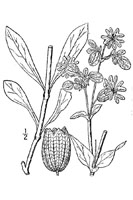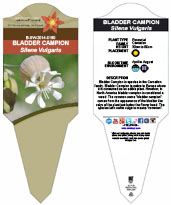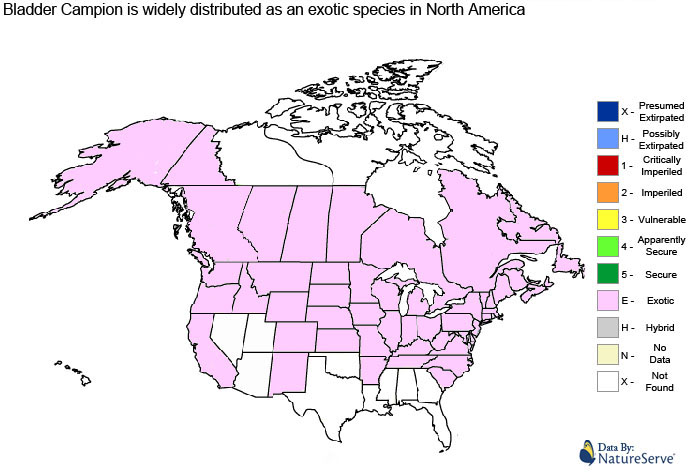Bladder Campion is species of Silene in the Carnation family. Bladder Campion is native to Europe where it is consumed as an edible plant. However; in North America bladder campion is considered a weed. The common name "bladder campion" comes from the appearance of the bladder like calyx of the plant just below the flower head. The species latin name vulgaris means "common".
Bladder Campion is grown in some European locations as an edible crop.
Within the realm of rational and holistic medicine, bladder campion is said to be emollient and is used in baths or as a fumigant. The juice of the bladder campion plant is used in the treatment of ophthalmia. Although no specific mention has been referenced for this species, verbal research shows bladder campion can be used as a soap substitute for washing clothes. The soap is obtained by simmering the root in hot water.
Please note that MIROFOSS does not suggest in any way that plants should be used in place of proper medical and psychological care. This information is provided here as a reference only.
The young shoots and leaves of bladder campion can be eaten raw or cooked. The young leaves are sweet and very agreeable in salads; and the the cooked young shoots, harvested when about 5cm long, have a flavour similar to green peas but with a slight bitterness. This bitterness can be reduced by blanching the shoots as they appear from the ground. When pureed, bladder campion is said to rival the best spinach purees. The leaves can also be finely chopped and added to salads. The leaves should be used before the plant starts to flower.

Bladder Campion is a perennial plant which can grow up to 60cm tall with opposite, lanceolate, deep green leaves. The leaf margin is entire, but occasionally wavy or curled and appearing toothed. The root system of bladder campion is made up of a coarse, whitish taproot with numerous, deeply penetrating and widely spreading wiry branches. The flowers appear in branching clusters with sepals united and forming a bladder-like calyx, light green or pinkish with darker green or purplish veins and 5 very short teeth at the end. Each flower contains five petals which are deeply lobed, white to pinkish, about 15mm across when open, soon curling up and shrivelling after pollination. Seedpods are nearly spherical, about 6mm long, enclosed by the loose, papery, bladder-like calyx. the seeds are grayish, kidney-shaped, and approximately 1.5mm across, rough with tiny warty bumps. The flowers of bladder campion are Dioecious (individual flowers are either male or female, but only one sex is to be found on any one plant) and therefore not self-fertile.
| Plant Height |
30cm to 60cm |
| Habitat |
Fields, Thickets, Clearings, Lawns |
| Leaves |
Opposite; Lanceolate |
| Leaf Margin |
Entire |
| Leaf Venation |
Longitudinal |
| Stems |
smooth stems |
| Flowering Season |
April to August |
| Flower Type |
Radially Symmetrical |
| Flower Colour |
White |
| Pollination |
Bees, Insects |
| Flower Gender |
Dioecious (individual flowers are either male or female, but only one sex is to be found on any one plant so both male and female plants must be grown if seed is required) |
| Fruit |
Hard kidney shaped seeds |
| USDA Zone |
5B (-23°C to -26°C) cold weather limit |
No known health risks have been associated with bladder campion. However ingestion of naturally occurring plants without proper identification is not recommended.
 |
-Click here- or on the thumbnail image to see an artist rendering, from The United States Department of Agriculture, of bladder campion. (This image will open in a new browser tab) |
 |
-Click here- or on the thumbnail image to see a magnified view, from The United States Department of Agriculture, of the seeds created by bladder campion for propagation. (This image will open in a new browser tab) |
Bladder Campion can be referenced in certain current and historical texts under the following three names:
Bladder Campion can be translated into the following select languages: |
| Arabic |
المثانة كامبيون |
Bulgarian |
мехур Кемпиън |
Chinese (Sim) |
膀胱坎皮恩 |
| Croatian |
|
Czech |
|
Danish |
|
| Dutch |
|
Esperanto |
|
Estonian |
|
| Finnish |
|
French |
|
German |
Leimkraut |
| Greek |
|
Hebrew |
שלפוחית השתן קמפיון |
Hungarian |
|
| Italian |
|
Japanese |
膀胱カンピオン |
Korean |
방광 후보에 |
| Punjabi |
|
Lithuanian |
|
Norwegian |
|
| Persian |
مثانه کمپیون |
Polish |
|
Portuguese |
candelária de bexiga |
| Romanian |
|
Russian |
Мочевой пузырь Кэмпион |
Slovak |
|
| Spanish |
coronaria de vejiga |
Swedish |
|
Tagalog |
|
| Turkish |
|
Ukrainian |
Сечовий міхур Кемпіон |
Vietnamese |
|
The information provided in this conservation assessment has been provided by the Natureserve Database in conjunction with various federal, provincial, state, county, district, regional, and municipal governments as well as public and private conservation authorities. Information in this section is accurate from the last time this article was updated.
|
 |
Bladder Campion has no conservation status as it is considered an exotic and or invasive species in North America. |
 |
The MIROFOSS database offers free printable garden tags for personal and non-profit use. These tags can be used to properly identify plant samples in a garden. Click on the tags shown on the the screen or -click here- to download a full size jpeg image for a bladder campion identification tag; which can be printed on paper or used with a plastic laser printer. |
 |
What's this?
This is a QR code (short for Quick Response) which gives fast-track access to MIROFOSS articles. QR Codes are barcodes that can be read by smart phone cameras. This QR Code is unique to this MIROFOSS article.
What can I do with it?
You can copy and print the QR code to a plant label, poster, book, web site, magazines, or newspaper so smart phone users can scan the QR Code which automatically takes them to this specific article. |

| Description |
Kartesz, J.T. 1999. A synonymized checklist and atlas with biological attributes for the vascular flora of the United States, Canada, and Greenland. First edition. In: Kartesz, J.T., and C.A. Meacham. Synthesis of the North American Flora, Version 1.0. North Carolina Botanical Garden, Chapel Hill, N.C. |
| Description |
Meades, S.J. & Hay, S.G; Brouillet, L. 2000. Annotated Checklist of Vascular Plants of Newfoundland and Labrador. Memorial University Botanical Gardens, St John's NF. 237pp. |
| Description |
The Nature Conservancy. 2001. Map: TNC Ecoregions of the United States. Modification of Bailey Ecoregions. Online . Accessed May 2003. |
| Folklore |
Kleonikos G. Stavridakis , Κλεόνικος Γ. Σταυριδάκης (2006). Wild edible plants of Crete - Η Άγρια βρώσιμη χλωρίδα της Κρήτης. Rethymnon Crete. ISBN 960-631-179-1. |
| Biology |
Dickinson, T.; Metsger, D.; Bull, J.; & Dickinson, R. (2004) ROM Field Guide to Wildflowers of Ontario. Toronto:Royal Ontario Museum, |
| Image Rendering |
USDA-NRCS PLANTS Database / USDA NRCS. Wetland flora: Field office illustrated guide to plant species. USDA Natural Resources Conservation Service. |
| Environment |
National Audubon Society. Field Guide To Wildflowers (Eastern Region): Alfred A. Knopf. ISBN 0-375-40232-2 |
| Physical Identification |
National Audubon Society. Field Guide To Wildflowers (Eastern Region): Alfred A. Knopf. ISBN 0-375-40232-2 |
| September 02, 2016 |
The last time this page was updated |
| ©2021 MIROFOSS™ Foundation |
 |
|
|



















